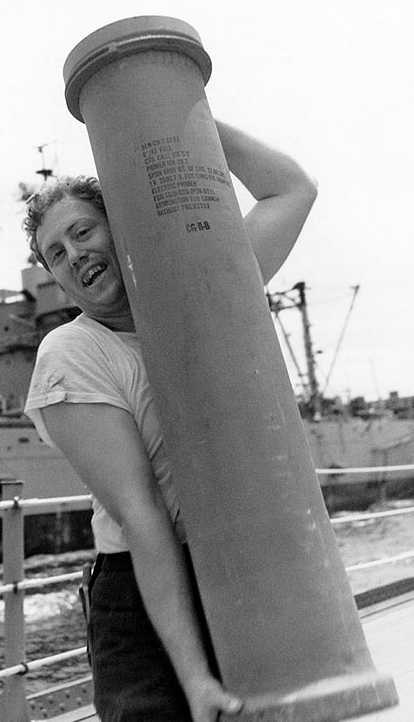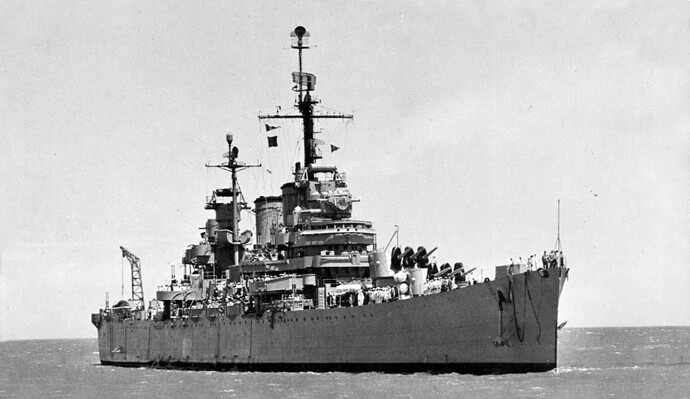Probably not, she was an old lady and crewed mainly by conscripted cadets with little or no real training.
Many couldn’t even work the signalling devices in the life rafts.
One of the torpedoes that hit her, pretty much vented the bow area to sea, she was sailing at a leisurely 10 knots at the time and not prepped for battle. Doors were open and most of the crew stood down.
The second hit between the two largest compartments on the ship. Once the boilers in these rooms started exploding, as the cold sea water hit the red hot boilers, the crew could do very little.
Added to this was the fact that this torpedo also cut power to the whole ship. This is why no distress call was ever made by radio. The Destroyers didn’t know she was doomed, and couldn’t see the flares and lights that were frantically calling for assistance. They, lacking any serious ASW equipment, sped off and did not engage the Submarine.
Although she was steaming AWAY from the Falklands this was only after the Argentines had decided conditions were unfavourable for an attack. She was steaming towards Argentina, but not to Argentina. The Captain was awaiting further orders.
Of the three groups of ships, only the 2nd flottila (centred around the 25 de Mayo carrier) engaged the Royal Navy en route to the Falklands. Mainly becaues of bad coordination.
The Argentine government were aware taht the British could strike ANY military vessel ANYWHERE, ANYTIME in the world. But this was not passed on to the Capt of the Belgrano. It is this part of the British warning to the Argentines and the set up of the exclusion zone that centres the whole arguement.
The torpedos were WW2 vintage design, and so was the Belgrano. She had been at sea for 50 years, and was only given an annual refit, which was cut short in '82 to provide work men for the rest of the fleets refits and repairs etc.
It is odd that the key attack on Britian (regarding the sinking) is that
- She was sailing away from the Islands (sometimes believed to be going to port but this was not the case) and of no threat to the British.
This was AFTER an intended attack had been canceled, that she would have taken part in. QED she was a threat.
- She was outside the TEZ. She was still inside the much larger TEZ imposed by the Argentines, after the British imposed theirs. The British had indicated that Argentine military ships and aircraft or civil ships and aircraft undertaking military operations, including reconnaissence of the task force would be dealt with.
On the 23rd April 1982 the following message was passed, via the Swiss Embassy in Buenos Aires, to the Argentine government.
In announcing the establishment of a Maritime Exclusion Zone around the Falkland Islands, Her Majesty’s Government made it clear that this measure was without prejudice to the right of the United Kingdom to take whatever additional measures may be needed in the exercise of its right of self-defence under Article 51 of the United Nations Charter. In this connection Her Majesty’s Government now wishes to make clear that any approach on the part of Argentine warships, including submarines, naval auxiliaries or military aircraft, which could amount to a threat to interfere with the mission of British Forces in the South Atlantic will encounter the appropriate response. All Argentine aircraft, including civil aircraft engaged in surveillance of these British forces, will be regarded as hostile and are liable to be dealt with accordingly.
Interviews conducted by Martin Middlebrook for his book, The Fight For The Malvinas, indicated that Argentine Naval officers understood the intent of the message was to indicate that any ships operating near the exclusion zone could be attacked. Argentine Rear-Admiral Allara who was in charge of the task force that the Belgrano was part of said, “After that message of 23 April, the entire South Atlantic was an operational theatre for both sides. We, as professionals, said it was just too bad that we lost the Belgrano”.
- The attack was a deliberate ploy to scupper the peace process. Although the Argentine Junta decided to wait for the outcome of the Peruvian Peace Proposal, and thus suspended operations on the 1st of May. The Argies had ALREADY conducted attacks on the British, well in fact they wanted to. It’s just none of them came off.
After hostilities broke out on May 1, 1982, the Argentine carrier attempted to launch a wave of Skyhawk jets against the Royal Navy Task Force after her S-2 Trackers detected the British fleet. Poor winds prevented the heavily loaded jets from being launched.
It is important to remember that the crux of the whole Argentine plan, to retake the islands, revolved around one thing. They owned them, keep the British away, until the South Atlantic winter and then hope they got to keep them by the time Spring came. After discussions.
To say that the British scuppered the peace process, after the Argies took the Falklands through aggression, not just lethargy on the British part. And attempted to engage the British Task Force whilst they were on route.
From http://www.bobhenneman.info/belgrano.htm
The Argentine Navy launched an ambitious operation, to project their power around the Falklands and perhaps even catch the incoming British task force and take it under attack before it was ready. Task Force 79 was formed, and disposed into three groups. Task Force 79.1 was the carrier 25 de Mayo, while 79.2 was her escort of two British built Type 42 destroyers, Hercules and Santisima Trinidad. Force 79.3 was the Belgrano and two escorting destroyers, and Force 79.4 consisted of 3 frigates. Force 79.4 sailed South of the Falklands, where it played no part in the following week’s events, and was recalled to base May 2.
79.1 & 2 sailed north of the Falklands, where they found nothing but misfortune. First, Santisima Trinidad’s Lynx helicopter crashed. Then the force was detected by a British Sea Harrier (no 801). Hercules attempted to launch a Sea Dart missile against it, but the launcher would not fire so the Sea Harrier escaped unscathed. Finally, 25 de Mayo was unable to launch her Skyhawk attack planes to locate and attack the British, as the carrier was too short to operate the aircraft without a significant head wind, and it was an unusually calm day in the South Atlantic. Having been discovered by an enemy they could not themselves locate, the Argentine Navy called off the operation and turned for home.
So the British are bad because they got the drop on the Argies? I take it the Argies would be holding themselves to such charges of scuppering hte peace process had they managed to shoot down the Harrier or actually got an air attack in the air to engage the British Task Force.





 describe wich part of my post “I paint” the british seamen as monsters. You are too tense, I suggest that get relaxed a bit.
describe wich part of my post “I paint” the british seamen as monsters. You are too tense, I suggest that get relaxed a bit.
